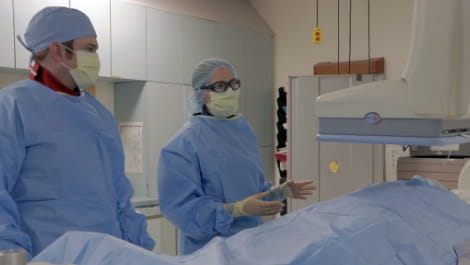What is Interventional Radiology?
Interventional Radiology is a medical subspecialty that uses image-guided, minimally invasive procedures to treat a wide variety of diseases. In contrast to radiology, which uses imaging procedures like MRI, CT and ultrasounds to diagnose conditions or injuries, interventional radiology uses these same imaging tools to help treat and cure conditions.
Interventional Radiology procedures often have fewer risks and shorter recovery times than traditional more invasive surgery. Because interventional radiologists look inside the body with imaging tools, treatments are often very precise and highly effective.
What Conditions Can Interventional Radiologists Diagnose and Treat?
Interventional Radiologists work with a range of medical specialties and can operate on a number of the body’s systems. While the list of interventions we can perform is always evolving and growing, below are some of the most common conditions we evaluate and treat.
Venous & Arterial Conditions
A doctor may refer you to an Interventional Radiologist to treat problems in your circulatory system including your arteries and veins. Some of the treatments we offer include angiography (used to evaluate arteries and veins for abnormalities such as tumors or bleeding), embolization (used to cut off the blood supply to bleeding or abnormal vessels), and stent placement to repair abnormally large vessels (aneurysms) or closed vessels that need to be reopened. Interventional Radiologists also remove blood clots and can treat veins in your legs that cause pain and swelling.
Trauma & Bleeding
Interventional radiology plays a key role in stopping bleeding, most typically in the setting of traumatic injury, bleeding in your gastrointestinal system, bleeding due to fibroids, or bleeding related to child birth.
Cancer
Our doctors assist in the diagnosis and treatment of certain cancers. We use imaging-guided biopsies to get small pieces of tissue that are then evaluated fora potential cancer. We can also perform cancer treatments either by delivering chemotherapy or radiation directly to tumors through the blood vessels or by applying thermal energy (either hot or cold) directly to tumors using probes placed through the skin. We commonly treat cancers in the liver, kidneys, lungs, and bones using these methods.
Musculoskeletal Pain & Conditions
Our minimally invasive treatments can also relieve pain caused by certain musculoskeletal conditions, such as arthritis and compression fractures in the spine. Interventional Radiologists use steroid injections in joints and the lower back to provide pain relief. For compression fractures, a cement like material can be injected into the bones of the spine for stabilization and pain relief. Image-guided injections of nerves in certain parts of the body also provide pain relief.
Do I need a referral to visit Interventional Radiology?

Referrals are required for procedure requests but are not necessary for clinical consultation. Your doctor can submit a referral using EpicCare.
About Our Team
Denver Health Interventional Radiology is made up of four fellowship trained physicians from across the country. We provide provide expert clinical consultation for patients and referrers along with the full range of interventional radiology procedures. Our program is the only site in Denver creating endovascular dialysis access fistulas.
Diagnostic procedures
- Angiography – Real time imaging of arteries and veins throughout the body to evaluate for narrowing of blood vessels or sites of bleeding, angiography is often followed by treatment of any abnormalities found, usually during the same setting
- Biopsy – Image-guided, targeted biopsy throughout the body in order to assist in a diagnosis, typically in the diagnosis of cancer
- Drainage – Image-guided placement of tubes to drain abnormal, often infected fluid, from the body. The removal of fluid often provides symptom relief, and the fluid is analyzed to help determine if antibiotics are needed.
Minimally invasive endovascular interventions
- Embolization
- Trauma embolization – treatment to stop life threatening traumatic bleeding, most commonly in the setting of acute injury to solid organs in the abdomen (spleen, liver, kidney) or related to bleeding from pelvic fractures
- Uterine artery embolization – treatment for bleeding or bulk symptoms in women with uterine fibroids or for bleeding after childbirth
- Prostate artery embolization – treatment for urinary symptoms (such as frequent need to use the bathroom) in men with an enlarged prostate
- Bronchial artery embolization – treatment for hemoptysis (coughing up blood) due to cancer or infection
- Gastrointestinal embolization – treatment for upper and lower gastrointestinal bleeding due to ulcers or other abnormalities of the GI tract
- Venous thrombolysis, ablation, recanalization, and stenting
- Deep venous thrombolysis – treatment to break down blood clots in legs and pelvis
- Pulmonary embolism thrombolysis – treatment to break down blood clots in the lungs that can cause shortness of breath, chest pain, and heart problems
- Venous ablation – treatment to close down painful varicose veins in the legs
- Venous recanalization and stenting – treatment to open closed or partially closed vessels in the abdomen and chest using stents for conditions such as May-Thurner syndrome
- Dialysis access interventions
- Fistulagram – diagnostic and therapeutic intervention on dialysis access fistulas and grafts to evaluate sites of dysfunction and treat these areas with angioplasty (balloon expansion) and/or stent placement to open vessels and improve blood flow
- Fistula declot – restoration of blood flow in a dialysis fistula or graft that no longer works due to blood clot
- Endovascular fistula creation – Creation of dialysis access fistula using catheters within the blood vessels. This is less invasive than open surgical creation of a dialysis access fistula
- Tunneled dialysis catheter placement – placement of a catheter into a vein in the neck to allow dialysis to be performed
- Arterial angioplasty and stenting
- Peripheral arterial disease interventions – diagnostic and therapeutic interventions to evaluate sites of vessel narrowing or obstruction and treat these areas with angioplasty (balloon expansion) and/or stent placement
- Aortic aneurysm repair – stenting of the thoracic or abdominal aorta to treat abnormal areas of expansion (aneurysm) which are at risk for rupture
- Abdominal aortic aneurysm endoleak interventions – diagnostic and therapeutic intervention to evaluate leaks around or into stents and stop these leaks with embolization
Minimally invasive hepatic interventions
- Biliary interventions
- Percutaneous transhepatic cholangiography – diagnostic evaluation of the liver bile ducts, often in the setting of duct blockage and therapeutic placement of drainage catheters to relieve the obstruction
- Biliary stenting – stent placement to provide more permanent relief of a duct obstruction, typically due to cancer
- Percutaneous cholecystectomy – placement of a drain into a blocked and/or infected gallbladder
- Portal hypertension management
- Transjugular intrahepatic portosytemic shunt (TIPS) creation – treatment for ascites or bleeding related to varices in the esophagus
- Balloon-occluded retrograde transvenous obliteration (BRTO) of varices – treatment for bleeding related to varices in the stomach
- Portal interventions
- Portal vein embolization – treatment to block the blood supply to one part of the liver to allow another part of the liver to grow bigger prior to liver surgery
Minimally invasive oncologic interventions
- Tumor ablation
- Kidney ablation – treatment of tumors in the kidney with hot or cold energy
- Liver ablation – treatment of tumors originating in the liver or tumors which have spread to the liver from another area of the body with hot or cold energy
- Lung ablation – treatment of tumors in the lung with hot or cold energy
- Bone ablation – treatment of tumors that have spread to bone and often cause pain with hot or cold energy
- Endovascular therapy for liver tumors (both those originating in the liver and those which have spread to the liver from another area of the body)
- Chemoembolization –delivery of chemotherapy through the blood vessels directly to the liver tumor
- Radioembolization – delivery of radiation therapy via radioactive particles (Ytrium-90) through the blood vessels directly to the liver tumor
- Port placement – placement of a port underneath the skin of the upper chest to allow easier access for intravenous chemotherapy
Therapeutic pain interventions
Spine interventions
- Kyphoplasty – treatment for compression fractures of the spine related to osteoporosis or cancer, cement like material is used to prevent further damage and reduce pain
- Lumbar epidural steroid injection – treatment for chronic low back pain related to nerve root compression
Nerve injection and ablation
- Celiac plexus block – treatment for abdominal pain often related to cancer
- Geniculate nerve block – treatment for knee pain often related to arthritis
- Appendicular interventions
- Joint steroid injections – Treatment for arthritis of joints of the arms and legs, most commonly hips and shoulders
Genitourinary interventions
- Nephrostomy placement – placement of a catheter into the kidney to drain urine if there is a blockage or infection
- Varicocele embolization – embolization of abnormal veins draining from the scrotum to provide relief of pain, swelling, and/or infertility
- Uterine artery embolization – treatment for bleeding or bulk symptoms in women with uterine fibroids or for bleeding after childbirth
- Prostate artery embolization – treatment for urinary symptoms (such as frequent need to use the bathroom) in men with an enlarged prostate
Miscellaneous interventions
- Gastrostomy placement – percutaneous placement of a feeding tube directly into the stomach
- Central venous catheter placement – placement of long-term intravenous access such as ports, tunneled central venous catheters or peripherally inserted central venous catheters (PICC)
- Inferior vena cava filter placement and removal – to prevent blood clots in the legs from traveling to the lungs in patients that cannot tolerate anticoagulant medications
- Lymphangiography and thoracic duct embolization – to diagnose and treat leaks of the lymphatic system in the abdomen and chest
- Paracentesis – to drain fluid from the abdomen that can result for liver problems, heart problems, or cancer
- Thoracentesis – to drain fluid from the chest that can result for liver problems, heart problems, or cancer



